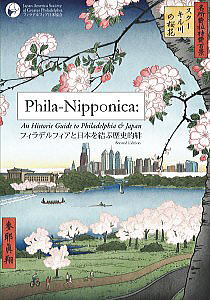| 史跡調査 遣米使節の旅 Historical Site Research - The Journey of the Japanese Delegation in 1860 フィラデルフィア Philadelphia 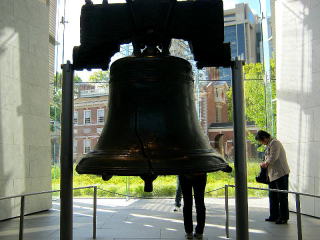 自由の鐘 Liberty Bell |
||
|---|---|---|
| サスケハナ河のフェリー Ferry on Susquehanna River メリーランド州ハーバー デ グレイス Havre De Grace, Maryland *文中の日付けは和暦で、( )内が日付変更済みの西暦* The year in the bracket is by the Japanese calender. |
||
| 万延元年(1860)、遣米使節団一行はワシントンからボルチモアを経て、四月 二十日(6月9日・土)に汽車でフィラデルフィアへ向けて出発した。途中、ボルチモアとの中間付近のサスケハナ河で体験したフェリーは衝撃的だった。 日記によれば、 「汽車が止まった。見ると大きな川があって橋がない。船に乗り換えだろうと下りる支度をはじめたら係官が「そのまま乗って行きますか、船で行きますか」と おかしなことを言う。そのまま待っていると、なんと汽車ごと船に乗せ、川を渡って向う岸に着くと、レールをつないで又すぐに走りだした。」 蒸気船に驚いた、汽車に驚いた、ではすまないものを見たことになる。日米の力の差を痛感したことだろう。 副使村垣は 「その不思議なことは驚くばかりである。汽車の中で眠っていた者は、川を渡ったことに気づかなかったろう」 と日記に書く。 |
||
| The Japanese delegation left Washington by train for Baltimore on
June 8, 1860 (April 20, the Year of Man-en 1st) and arrived at Philadelphia
next day. When they crossed the Susquehanna River on the way, they got
on a train ferry which carried their railway train on board. It was quite
a shocking experience for them because there was no such transportation
system in Japan at the time. According to the diary of Awajinokami Masanori Muragaki, the vice-envoy of the delegation, "The train stopped and I could see a big river in front of us, but no bridge was there. We began to prepare for getting off the train, assuming that we would take a ship. However, the American officer who was taking care of us asked us a funny question. "Would you like to stay in the train or get on the ferry?" We could not understand what he meant and we stayed in the train, anyway. Then the whole train was put on a ferry, which carried us to the opposite shore and we continued our journey on the railroad." During the journey, they were surprised at the steamers, the trains and now the train ferry. They must have really felt the difference in power between Japan and the United States. Muragaki continued to write in his diary. "It was amazingly marvelous. Some of our members who were sleeping at the time might have not noticed even crossing the river." |
||
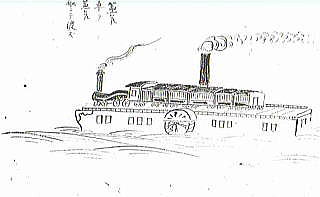 |
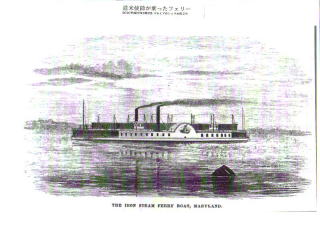 |
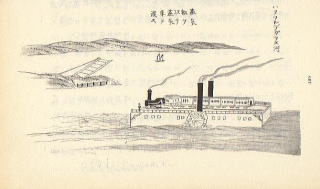 |
| ▲フェリー 佐藤藤七「渡海日記」 「蒸気車を蒸気船にて渡す」と驚きを記す。煙突を1本省略して描いている。 ▲ Train ferry drawn by Toshichi Sato in his diary “Tokai Nikki (Diary of Crossing the Pacific Ocean)”: He expressed his surprise in his diary, writing, "The steam engine train was carried across the river on board the steam ferry." He omitted a funnel in the drawing for some reason. |
▲フェリー「メリーランド号」 シェリル氏提供 初代フェリーはサスケハナ号で、1860年ごろは2代目のメリーランド号とのこと。 ▲ Train ferry, "Maryland" (Courtesy of Mr. Richard Sherrill of the Historical Society of Harford County, Inc.) : In 1860, the second ferry, "Maryland," was in operation succeeding the first ferry, "Susquehanna." |
▲フェリー 木村鉄太「航米記」 フェリーの二本の煙突、向う岸の桟橋▼も正確に見てスケッチした ▲ Train ferry drawn by Tetsuta Kimura in his diary, “Kobeiki (Report of visiting the U.S.)”: He drew the scene correctly with the two funnels and the wharves on the opposite shore. The wharves are depicted in detail in the drawing below. |
今回の調査で、サスケハナ河のほとりの街「ハーバーデグレイス」を訪ね、このフェリーの画像を探して町の図書館から、もう一つの図書館、さらに別の小さな博物館へと紹介されて訪ね、さらに隣町ベルエアのハーフォード郡歴史ソサイエティでようやくこのフェリー関連の画像をたくさん収集研究している学芸委員 Richard Sherill 氏に会うことができた。この時一行が乗ったフェリーは二代目の「メリーランド号」とわかった。 |
||
| On August 8, 2010, we visited Havre de Grace, Maryland, a town on the south bank of the Susquehanna River, looking for drawings or pictures of the train ferry which carried the Japanese delegation to Perry Point on the north shore of the river. In the town, we first visited Havre de Grace Branch Library, but they did not have any information. Suggested by the librarian there, we visited the visitor center next and then the lock house for a canal on the river which had some historical information. However, neither of them had what we were looking for. Then, a person at the lock house recommended us to visit a historical research institution in the town of Bell Air. After driving for thirty minutes, we were in the premises of the Historical Society of Harford County, Inc., where Mr. Richard Sherrill, the Archive Chairman of the institution, kindly provided us with some drawings we were looking for. He also said that the train ferry the Japanese delegation took had been "Maryland," the second ferry for the crossing, succeeding the first ferry, "Susquehanna." | ||
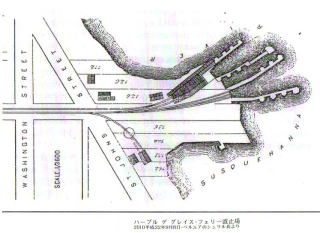 Mr.Sherrill提供 Courtesy Mr. Richard Sherrill |
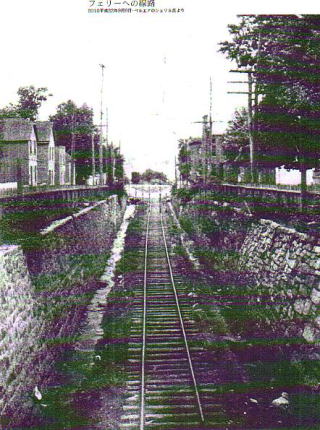 Mr.Sherrill提供 Courtesy Mr. Richard Sherrill |
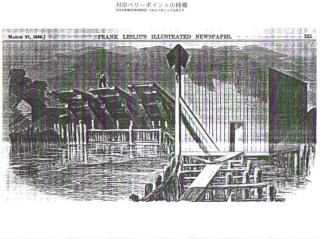 Mr.Sherrill提供 Courtesy Mr. Richard Sherrill |
| ▲波止場 3本ある波止場のうち、いちばん左上がフェリーに使われたという。あたり一帯が今は何の変哲もない新興住宅地になって▼町民の記憶になっていない。 ▲ Wharves in Havre de Grace: The wharf at the north end was used for the train ferry. The wharves are all gone now and the place is just a residential area with new houses. Very few people in the town seem to know about the historical past. |
▲波止場への引き込み線 使節の乗った汽車はこの線路で波止場へ下って、船に乗せられた。現在は下の景色▼になっている。 ▲ Railroad to the ferry wharf: The train with the Japanese delegation on board ran through this railroad and was loaded on board the ferry. Today, all the rails have been removed and there is Pennington Avenue at the place. The avenue is shown in the photo below. |
▲桟橋 対岸のペリーポイントでフェリーの到着を待つ桟橋(左の3枚)。水面の上下に合わせて、高さを調節できる。 ▲ Ferry Wharves at Perry Point on the north shore of the river: One of the three drawn-up wharves on the left is put down when it receives a train from an arriving ferry. The height of the wharf could be adjusted for the tide. |
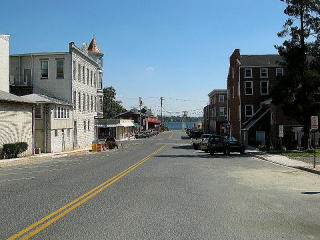 |
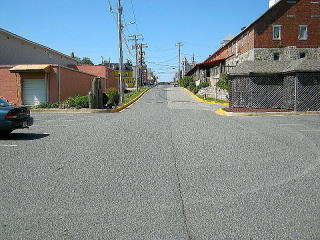 |
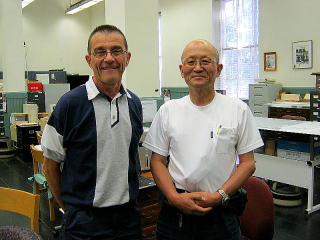 |
| ▲ハーバーデグレイス この町は今は静かな田舎の町だが、かつていまのワシントンの地とともに首都の候補地に挙げられ、国会でワシントンの地と同数となり、議長の採決でワシントンの地に決まった。 ▲ The town of Havre de Grace: It is a quite remote town in Maryland now, but it could have been the capital of the United States if the things had gone differently. In 1789, when the House of Representatives voted as to the permanent location of the capital, it was a tie between Havre de Grace and Washington. The deciding vote, cast by the Speaker, was for Washington. |
▲シェリル氏(Mr. Richard Sherrill ハーフォード郡歴史ソサイエティの学芸員)が貴重なフェリーの資料を収集していた。 ▲ Mr. Richard Sherrill: Mr. Sherrill, the Archive Chairman of the Historical Society of Harford County, Inc., is a collector of archives in the area and he kindly shared those valuable drawings and information about the ferry with us. |
|
| ▲ハーフォード郡歴史ソサイエティの学芸員シェリル氏を訪ねると、日本人がなぜフェリーの歴史を調べに来たのか、と不審な様子。遣米使節一行の150年前の体験を持参したパンフレット「遣米使節三船」(Japanease/Engilish)で説明すると、佐藤藤七のフェリーの絵を見てシェリル氏は驚き、「このメリーランド号に機関車を乗せて運んだのは、リンカーン大統領就任の時が最初だと思っていたので、歴史が変わった」、と大変喜びました。 ▲At first, Mr. Sherrill seemed quite puzzled because he could not figure out why two Japanese people were visiting such a remote town to do research on the history of the train ferries. I immediately took out from my bag a copy of the brochure, "Three Ships That Carried the First Japanese Embassy to the United States Around the World,"and explained the Japanese delegation's journey in the United States in 1860. Then, I showed him the drawing of the ferry by Toshichi Sato in the brochure. He looked very surprised at the drawing and said, "I have been thinking that the ferry Maryland carried a train for the first time with President Abraham Lincoln on board when he was on his way to Washington for his first presidential inauguration in March, 1961. I now know that I was wrong and the history has been rewritten." |
||
| フィラデルフィアの歓迎パレード Reception and Parade in Philadelphia |
||
| 駅からブロウド通りを北上し→→ウオールナッツ通りで左折して西へ進み→→19番通りを右折して北へ進み→→アーチ通りで右折して東へ進み→→3番通りで右折して南へ進み→→チェスナッツ通りで右折して西へ進み公園前を通って→→コンチネンタルホテルへ到着した。 On June 9, 1860, the Japanese delegation arrived at the station located near today's intersection of Washington St. (called Prime Avenue at the time) and Broad St. Then, they paraded the streets of the city, through Broad St. to the north, Walnut St. to the west, Nineteenth St. to the north, Arch St. to the east, Third St. to the south and Chestnut St. to the west, and then arrived at the Continental Hotel. |
||
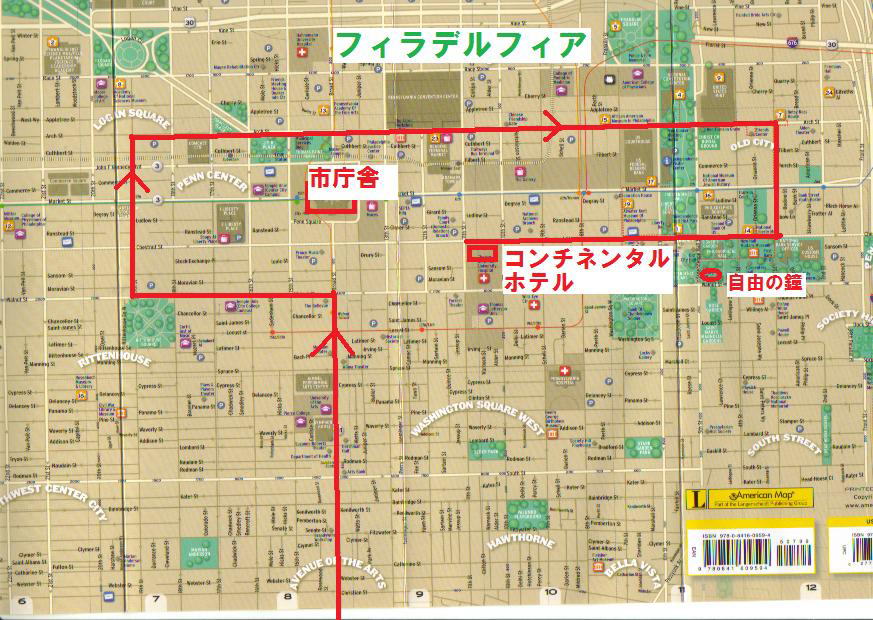 |
||
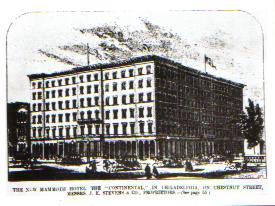 |
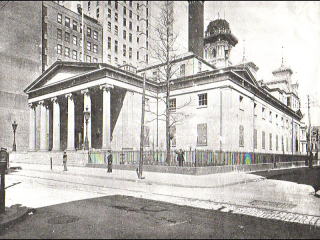 |
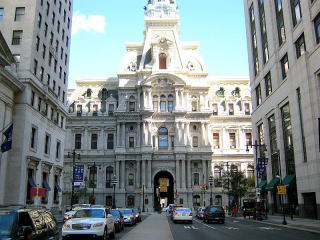 |
| ▲コンチネンタル・ホテル 現存しない 写真:宮永孝氏提供 ▲ The Continental Hotel (Courtesy Mr. Takashi Miyanaga): It does not exist now. |
▲造幣局 ここで小栗忠順は日米金貨の分析実験を主張し、立ち会った 写真:宮永孝氏提供 ▲ Philadelphia Mint (Courtesy of Mr. Takashi Miyanaga): At the mint, Kozukenosuke Tadamasa Oguri insisted on having an assay test of gold coins of both countries and successfully had it done.. |
▲市庁舎 素晴らしい建物で、一行はこれを正面に見て行進した。 ▲ City Hall: The Japanese delegation paraded the street by the city hall, looking at the front side of this beautiful building. |
| 図書館で当時の新聞「フィラデルフィアインクワイアラー」などのマイクロフィルムを探し、フィルムリーダーで遣米使節関連の記事を見つけてプリントする。小銭を入れてプリントする方式だが、どんどん小銭がなくなり、廊下の両替器で替えてくるがすぐになくなる。記事はきれいにフィルムに入っていないから、ピンボケだったり、黒くなっていたり。 At a library, we looked for microfilm of the Philadelphia Inquirer and other newspapers of the time, and used a film reader provided there to find articles related to the mission to the United States and print them. The printing system was to insert coins into the machine and print, but the coins kept disappearing. We had to change them at the money changer in the hallway, but they soon ran out. The articles were not printed neatly on film, so they were sometimes out of focus or blacked out. |
||
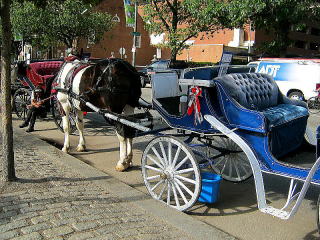 |
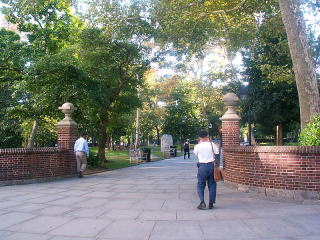 |
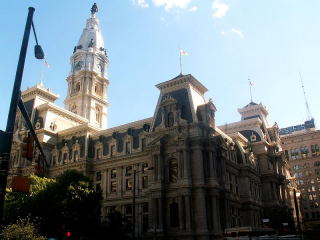 |
| ▲観光馬車 使節一行もこんな馬車に乗せられたのだろうか ▲ Horse-drawn carriage: I imagine that the Japanese delegation paraded the streets on carriages like this. |
▲公園 この前をパレードした。煉瓦の塀や門柱は当時のままかもしれない ▲ Park: The Japanese delegation paraded the streets around the park near the old city. They may have seen these brick walls and gateposts during the parade. |
▲市庁舎タワー 展望台へ上がれるそうだが、今回は時間がない。 ▲ The tower of the city hall: It was accessible to the top, but we did not have enough time. |
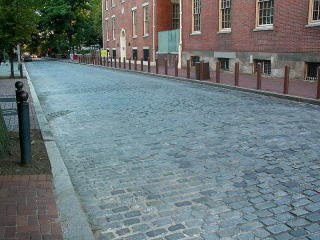 |
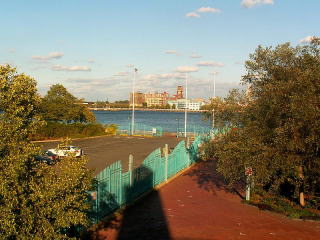 |
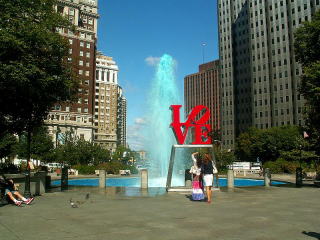 |
| ▲石畳の街 パレードした通りには、すり減った石畳が残っていた。 ▲ Stone pavements: We saw footworn stone pavements on the streets which they paraded on. |
▲対岸のカムデン 一行はニューヨークへ向かう朝、川を渡ってカムデンから汽車に乗った。 ▲ City of Camden on the east shore of the Delaware River: On June 16, 1860, the Japanese delegation crossed the river by boat and got on a train at the Camden station for New York. |
▲近代ビル街 青く色を付けた噴水はきれいというか、不気味というか ▲ Modern Buildings of Philadelphia: The blue-colored fountain looked rather ominous than beautiful. What do you think? |
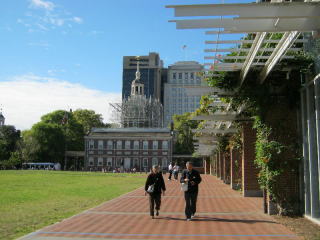 |
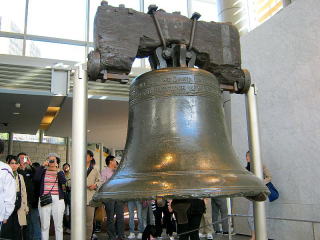 |
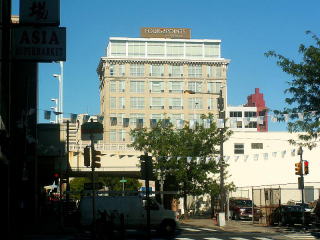 |
| ▲リバティ・ベル・センター 世界各地からの客で朝から行列が出来ていた。ニューヨークへ戻る朝、急いで立ち寄った。 ▲ Liberty Bell Center: I visited the Liberty Bell Center on the morning of September 10, 2010, before traveling to JFK Airport, New York. It was very crowded with tourists from abroad lining up despite the early hour of the morning. |
▲自由の鐘 ここを訪れた、チベットのダライ・ラマと南アフリカの・ネルソン・マンデラ大統領の大きな写真が印象的だった。 ▲ Liberty Bell: The Liberty Bell is an iconic symbol of American Independence. I found pictures of Dalai Lama of Tibet and Nelson Mandela of South Africa on the walls surrounding the bell and they looked impressing. |
▲泊まったホテル シェラトン・フィラデルフィア・シティセンターはしっかり出来た部屋で快適だった。 ▲ Hotel we stayed: Four Points Philadelphia City Center by Sheraton was not a gorgeous but new and well-furnished hotel. |
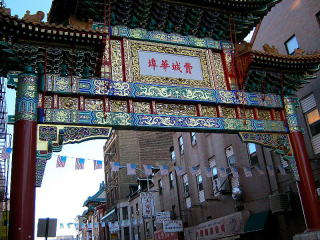 |
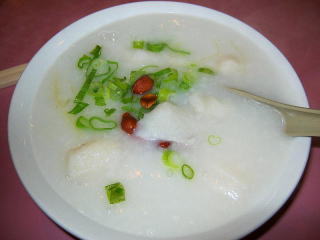 |
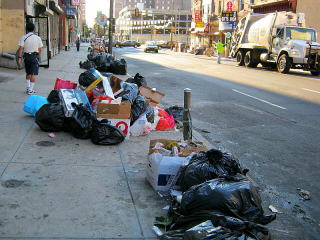 |
| ▲中華街 ホテルの近くの中華街で朝夕の食事をとった。安心して注文できる。 ▲ China Town: We had breakfast and dinner at restaurants in Chinatown. They served very good dishes especially compared with Chinese dishes in Baltimore and Washington. |
▲朝食のお粥 外国旅行は食べ過ぎると体調を崩すから、朝食のお粥はありがたい。おいしかった ▲ Congee for breakfast: I had congee for breakfast in Philadelphia and it tasted wonderful. I tend to eat too much in trips abroad and upset my health, so I tried this time to be a good boy with light foods. |
▲ゴミ 中華街はなぜか汚い。 ▲ Garbage: I don't know why, but Chinatowns are sometime in unsanitary condition. Unfortunately, Philadelphia was not an exception. |
